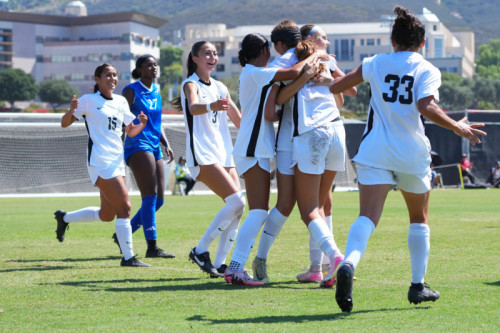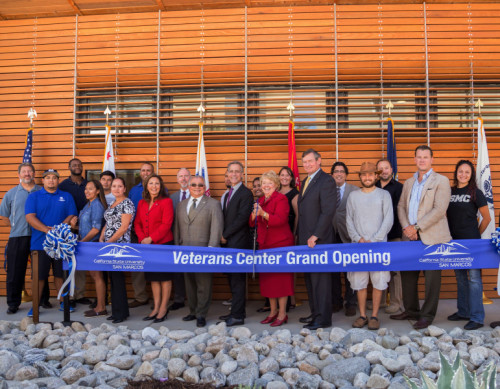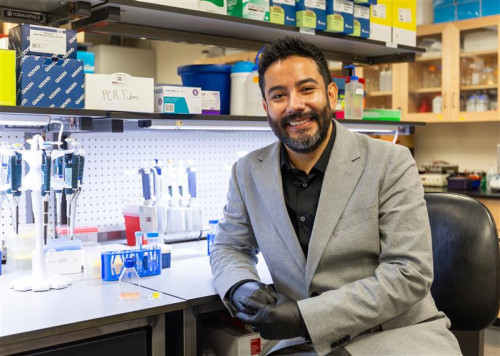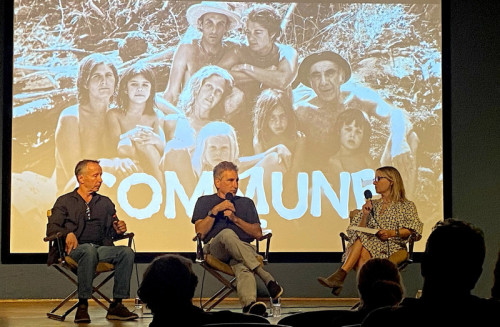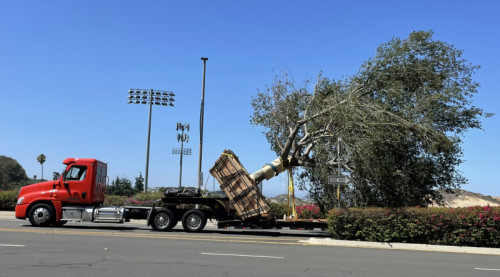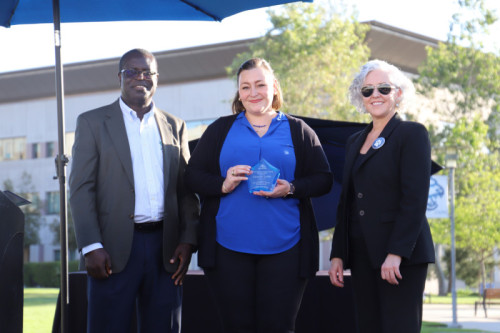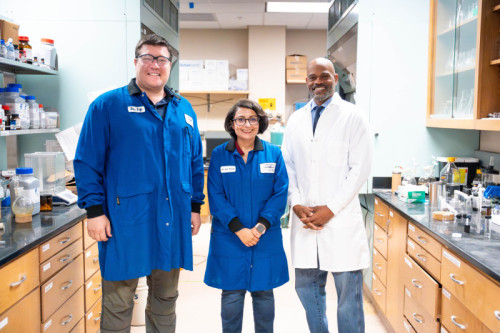Women's Soccer Team Finishes Nonconference Play With Win
01
October
2025
|
07:44 AM
America/Los_Angeles
The Cal State San Marcos women's soccer team beat Cal State San Bernardino 1-0 in its final nonconference match on Sunday. Photo by Brandon Pollard
Cal State San Marcos players celebrate during Sunday's 1-0 victory over Cal State San Bernardino. Photo by Brandon Pollard
CSUSM's Natalie Paulson had an assist to help lift the Cougars to a 1-0 victory over Cal State San Bernardino on Sunday. Photo by Brandon Pollard
CSUSM's Gabby Marsh (right) leaps toward Cal State San Bernardino's Sydney Trump on Sunday. Photo by Brandon Pollard
CSUSM's Brittany Brown controls the ball during Sunday's 1-0 win over Cal State San Bernardino. Photo by Brandon Pollard
CSUSM's Addison Leite (right) battles Cal State San Bernardino's Ruby Segura for the ball during Sunday's soccer match. Photo by Brandon Pollard
CSUSM's Luca Puccio played all 90 minutes during the Cougars' 1-0 victory over Cal State San Bernardino on Sunday. Photo by Brandon Pollard
CSUSM's Diana Mendoza (right) battles Cal State San Bernardino's Angelyn Pena for control of the ball. Photo by Brandon Pollard
"; items += "
"; items += "
"; items += "
" + val['title'] + "
"; if(val['subtitle']){ items += "
" + val['subtitle'] + "
"; } items += "
"; if ((val['showpublishdate'] !== 0 && showPublishDateHeadlineSetting) || showPublishCityHeadlineSetting) { items += '
'; if (val['publishcity'] && showPublishCityHeadlineSetting) { items += '
' + val['publishcity'] + '
'; } if (val['showpublishdate'] !== 0 && showPublishDateHeadlineSetting) { items += "
"; items += "
" + date_month + "
"; items += "
" + date_day + "
,"; items += "
" + date_year + "
"; items += '
'; items += ' | '; items += '' + val['publish_time'] + ''; items += 'America/Los_Angeles'; items += '
'; items += '
'; } items += '
'; } items += "
" + val['message'] + "
"; items += "
Read more
"; items += "
"; items += ""; items += tags_items; items += multimedia_count; items += "
"; } }); items +="
"; if (1 > 1) { pp_jquery(".pp_blockheadlines_items-7519288").append(items); } else { pp_jquery(".pp_blockheadlines_items-7519288 .pp-headline-block").hide().css("opacity","0"); pp_jquery(".pp_blockheadlines_items-7519288").append(items); pp_jquery(".pp-headline-block:visible").animate({"opacity":"1"},300); } }); } pp_jquery(window).on('load', function() { /** * targets calcEqualHeights function (modules_v2h.js) * calculates consistent height for all visible items per block module */ pp_jquery('.pp_blockheadlines_items-7519288 .pp-headline-block').each( function() { PP_MODULES.calcEqualHeights(this); }); }); pp_jquery(document).ajaxComplete(function() { /** * when using block item nav button calcEqualHeights * function (modules_v2h.js) will be executed */ pp_jquery('.pp_blockheadlines_items-7519288 .pp-headline-block').each( function() { PP_MODULES.calcEqualHeights(this); }); });
Latest Newsroom
- In Memoriam: Josh Pack (’97), a Life of Leadership, Generosity and HeartCal State San Marcos is mourning the passing of distinguished alumnus Joshua Pack ('97), who died on Sept. 29. A devoted husband and father, proud Cougar, and tireless advocate for veterans and students, Pack leaves behind a legacy defined not only by professional success but also by kindness, humility and a deep commitment to helping others. Pack’s path to CSUSM wasn’t straightforward. After beginning his higher-education journey at the U.S. Air Force Academy and transferring to another university, he eventually found his home at San Marcos, where he earned a bachelor’s degree in economics in 1997. He often credited a CSUSM economics professor with transforming his academic trajectory and helping set the foundation for his career. Professionally, Pack rose to become co-CEO of Fortress Investment Group, one of the world’s leading investment firms. Over more than two decades, he built a reputation as a leader in credit and real estate investing, overseeing billions of dollars in assets and guiding teams through complex financial markets. Pack’s connection to CSUSM remained strong long after graduation. He gave his time and expertise as a member of the CSUSM Foundation Board from 2011-16, including service on the Fundraising Committee, where his vision helped strengthen the university’s philanthropic efforts. He also supported the Finance Society by offering real-world insights to students preparing for their own careers. Pack’s passion for serving veterans was rooted in his upbringing as the son of Lt. Col. A.J. Pack, a U.S. Marine Corps officer who served for 22 years. Like Josh, Lt. Col. Pack served as a director of the CSUSM Foundation Board (2015-21). In his father’s honor, Josh established the Lt. Col. A.J. Pack Veterans Scholarship at CSUSM, supporting military-affiliated students in pursuing their educational and career goals. He also championed the creation of a veterans and military center on campus, which broke ground in 2013, calling the work “enormously gratifying for me and my family.” In 2014, he partnered with the Veterans Center and Associated Students, Inc., to host the campus premiere of “The Hornet’s Nest,” a documentary about American troops in Afghanistan. The event included a post-screening Q&A with military units and filmmakers, underscoring his belief in the importance of recognizing and supporting student veterans. In 2021, Pack reflected on his connection to CSUSM in an article on the Fortress website, noting how meaningful it was to help create a leading center for veterans and active-duty service members at the university. “The CSUSM veterans community has earned not just our thanks, but our commitment to support their dreams,” he said. Pack will be remembered for the generosity he showed to his alma mater and to the veteran community that meant so much to him. Through the Lt. Col. A.J. Pack Veterans Scholarship, his support of campus programs and his advocacy for military-connected students, he built a legacy of service that will continue to impact lives for years to come. Pack is survived by his wife and their four children. “Josh was a true partner in our mission of student success,” CSUSM President Ellen Neufeldt said. “He had an unwavering belief in the power of education, and he never forgot where he came from. His impact on our students, and especially our student veterans, will endure for generations, and we will carry forward his spirit of service with gratitude.” Media Contact Eric Breier, Interim Assistant Director of Editorial and External Affairs ebreier@csusm.edu | Office: 760-750-7314
- Biology Professor Researching Breast CancerCarlos Luna Lopez’s typical day in the lab looks a little different from others. Dark, cool and full of machinery like 3D bio printers, the lab is home to petri dishes full of cancerous cells. Inspired by one of his students, his lab cohort is studying breast cancer. “Being in Dr. Luna’s lab has been such a great experience. He’s not only an amazing PI, but also a really great mentor,” said Oscar Loyola Torres, a molecular and cellular biology student. Luna, a biology professor at Cal State San Marcos, received a bachelor’s degree in physics from Universidad de Sonora in Mexico and a Ph.D. in bioengineering from the University of Maryland. He decided to pursue postdoctoral research closer to his parents, who live in Mexico, which brought him to UC San Diego. Luna always knew he wanted to pursue a career in the STEM field, as his father is a mechanical engineer and his mother a nurse. During his Ph.D. studies, he joined the Summer Program in Neuroscience, Excellence and Success (SPINES), where he met a former CSUSM biology professor who further inspired his move to San Diego and his pursuit of a job at CSUSM. Luna believes that finding a good balance between research and teaching is important. He explained that one of his biophysics professors would play soccer with his students and invite them to important seminars, creating a meaningful relationship with the students beyond just research. So when he was told of the community between faculty and students at CSUSM, it felt like the right choice to apply. Luna has taught upper-division cellular and molecular biotechnology classes as well as biostatistics and bioengineering classes at CSUSM since 2017. He also occasionally teaches advanced molecular seminars, and currently he and his lab students are studying the effects of fat cells on breast cancer growth. The tests examine how lipid metabolism is driving parts of cancer growth. Lipid metabolism is the process of creating or breaking down lipids (fats) to help with energy storage, structural cell membrane support and cell signaling. Since breast tissue is full of lipids, it creates the perfect environment for cancer cells to thrive, utilizing these functions to their advantage. Luna and his students monitor the interactions between cancer cells and two different types of fat cells, white and brown adipocytes. These cells work to store energy, produce hormones and regulate body temperature, all basic functions crucial to the success of the human body. Utilizing his background in engineering, Luna and his students built a device that creates spheroids, 3D circular clusters of cells. The spheroid is made of biomaterials replicating human tissue, allowing the students to get the most accurate results from their cancer research. “There are so many things I get to learn from him and the lab that are helping me grow as both a student and a future physician,” Loyola Torres said. Luna said this is only a portion of what their research encapsulates. Every time a new discovery is made, it opens a door for further questioning, and the research continues. “When you have something in your mind and you get the chance and the resources to be able to put that into the world, it’s so exciting,” Luna said. Luna loves watching his students grow and be creative, as it reminds him of when he was a kid. Not only can he exercise his own creativity, but he gets to bring his students along for the journey. With him having watched some of them grow from first years to graduating Ph.D. students, the relationship Lopez has been able to create with his students makes his job all the more rewarding. Media Contact Eric Breier, Interim Assistant Director of Editorial and External Affairs ebreier@csusm.edu | Office: 760-750-7314
- Professor Goes on Tour for 20th Anniversary of Acclaimed FilmWhen Jonathan Berman came to Cal State San Marcos as a film professor in 2004, he was close to finishing a documentary about a Northern California commune during the counterculture era. The documentary was released the following year. Now, 20 years later, Berman is marking the anniversary of the film with a new digital restoration and a national tour of screenings and interviews. “Commune” is about an intentional community called Black Bear Ranch formed in 1968 in remote Siskiyou County just south of the Oregon border. A dozen people were expected to live there, but the number eventually swelled to 100 in what was a utopian experiment that attracted anarchists, hippies and activists seeking to get away from America and create something new. The documentary includes prominent actor Peter Coyote, who once lived at Black Bear. At the time of its release, “Commune” received positive reviews from such outlets as the New York Times, Variety, the Village Voice and the San Francisco Chronicle. It boasts a rating of 96% on Rotten Tomatoes. Berman says he decided to restore the film so that it would be suitable to appear on streaming services and that he chose to embark on a nationwide tour to give fans “the communal experience of theatrical.” The tour began in May in upstate New York and will end this month back in New York. In September, it made four stops in California, including Los Angeles and the Bay Area town of San Rafael, where some former Black Bear denizens reside. “Twenty years later, it is a warm feeling to reunite with those folks,” Berman said. “They have almost all gone on to do work that helps people; some of this can be gleaned in the film. It was almost like reuniting with relatives after a long time. I felt a little guilty for not really being in touch more, but then happy to see them again.” In addition to the 16 theaters that have screened “Commune,” Berman has been interviewed on nearly 20 podcasts. He’s hoping to add a few more showings in Southern California, including at least one in the San Diego area. After making “Commune,” Berman focused on teaching and consulting on other films before the release in 2018 of “Calling All Earthlings,” which examines California’s UFO counterculture cult and the Integratron, a mysterious structure in the desert north of Joshua Tree National Park. He’s now working on the third documentary in what he calls his California trilogy; titled “Gondola,” it’s about the controversial plan to build an aerial tram from Union Station to Dodger Stadium in L.A. Berman says his film work over the years has benefited greatly from the contributions of CSUSM students and fellow faculty members, from serving internships to watching and giving feedback on test edits. “That’s part of our mission as a university, for students to work intimately with teachers who are active in their field,” he said. Media Contact Brian Hiro, Communications Specialist bhiro@csusm.edu | Office: 760-750-7306
- 'It's Irreplaceable': Giant Oak Tree Saved in RelocationA giant oak tree as old as Cal State San Marcos itself was saved this month as part of a large-scale relocation project. The tree, which was planted around the time of CSUSM’s founding in 1989 and weighs 27 tons, was moved in early September from a plot outside the Arts Building to the area between Kellogg Library and Campus View Drive, near the main circle. “It’s not every day that you move a tree that size,” said Michelle Alves, a campus planner in Planning, Design and Construction (PDC) who helped supervise the project. The fate of the tree was thrown into question over the summer when Facilities Development and Management (FDM) began the construction of a new glass elevator on the perimeter of the Arts Building. Because the tree sat right next to the construction zone, the determination was that it would need to be uprooted to give it the best chance of survival. “That kind of oak tree, you could never buy one. It’s irreplaceable,” Alves said. The relocation occurred on Sept. 6 – a Saturday, to take advantage of minimal car and foot traffic on campus. Alves arrived at 5 a.m., planning to be on site for six hours; it turned out to be more than nine. In all, the project involved about 20 workers, including several from FDM and several more from an Escondido company called Big Trees Nursery. After landscapers boxed and harnessed the tree, a crane lifted it out of the ground and laid it on its side on a flatbed truck (a smaller truck after the first one proved too big to navigate the service road, causing an hour delay). On the drive northeast out of campus, the oak’s branches were so wide that they were brushing the overhang of the Arts Building and the trees outside Science Hall 2. “It looked like it was high-fiving other trees all the way down, like it was saying, ‘See you later,’ ” Alves joked. At a very deliberate, almost walking pace, the truck descended the service road to La Moree Road, re-entered campus near the Sprinter station and drove southwest on Campus View Drive to the tree’s new resting spot behind the library. Along the way, the precious cargo had a front and back escort from University Police Department vehicles. Now situated on the ground next to the main circle, the crane lifted the tree from the truck and deposited it in a pre-dug hole. Workers attached three braces to the trunk to provide support in case of wind or rain. The tree, which is about 40 feet tall and 30 feet wide, will be given vitamins and extra water in the coming weeks. “We’re setting it up for success and a long, happy life,” said Alves, adding that oak trees can live up to 300 years, making this one a relative baby. Alves said the project reflects CSUSM’s dedication to sustainability and its achievement last year of Level 1 arboretum accreditation and Tree Campus USA recognition. She also spotlighted the efforts of the university’s landscaping team, namely Raul Vaca and Ricardo Jacobo, with after-care by Isidro (Sid) Alvarez. “It was a team effort, and it took a team to pull it off,” she said. “Often, FDM is behind the scenes, like we’re the engine running the campus. But I want people to know that we do some really cool stuff.” Media Contact Brian Hiro, Communications Specialist bhiro@csusm.edu | Office: 760-750-7306
- Alumna Comes Full Circle in Return to School of EducationCassiopeia Guthrie has worn many hats in her career – educator, journalist, curriculum designer and arts advocate. But at the heart of it all is a deep commitment to equity, creativity and student success. A proud alumna of Cal State San Marcos and its School of Education, Guthrie serves as a Distinguished Teacher in Residence (DTiR) – a unique program that brings experienced educators into the university to teach, mentor and lead. DTiRs play a vital role in preparing the next generation of teachers by bridging theory and practice, offering students real-world insights and guidance rooted in classroom experience. In her role, Guthrie designs and teaches a wide range of undergraduate, credential and graduate-level courses. Her leadership extends beyond instruction, as she co-chairs the school’s Community Governance and DTiR committees and serves on the Education Recruitment Committee. “It has been an honor to come full circle by returning to teach in the School of Education," Guthrie said. “The faculty at CSUSM do an incredible job of preparing and inspiring future educators to create meaningful learning environments across our region. The opportunity to bring my classroom and real-world experience back to support our TK–12 candidates fills me with both joy and a deep sense of purpose.” Last year, Guthrie was honored with the College of Education, Health and Human Services Outstanding Alumni Award, a recognition of her impact on education and her continued dedication to CSUSM’s mission. Now, she’s taking on a new challenge as the faculty fellow for Project R.I.S.E. (Recruiting Inclusive, Supportive Educators), leading strategic programming and planning to support sustained outreach across partner school districts. Her work will lay the foundation for a future Project R.I.S.E. Center, envisioned as a regional hub to strengthen recruitment and pipeline development for aspiring educators. “Cassiopeia brings a unique blend of creativity, strategic thinking and heart to everything she does,” said Moses Ochanji, director of the School of Education. “Her leadership in Project R.I.S.E. will help us build lasting partnerships and expand opportunities for future teachers.” Guthrie’s journey began with a bachelor’s degree in journalism from San Diego State, followed by a teaching credential at CSUSM and an MBA from a private university. She is pursuing a Doctor of Education in Educational Leadership through the joint doctoral program between CSUSM and UC San Diego, with a research focus on how political rhetoric affects teachers’ emotional responses in polarized times. Her resume includes roles such as a curriculum and educational technology specialist, marketing communications officer, and arts integration fellow with CSUSM’s Center ARTES. She also has served as a journalist and theater critic, earning multiple San Diego Press Club awards and contributing to outlets such as San Diego Magazine and San Diego Story. Whether she’s leading professional development, designing equity-focused curriculum or mentoring future educators, Guthrie’s work reflects CSUSM’s commitment to innovation and developing creative solutions in partnership with the community. Support leaders like Cassiopeia Guthrie and programs like DTiR, Project R.I.S.E. and Center ARTES by contributing to CSUSM’s “Blueprint for the Future” fundraising campaign. Your gift helps us innovate in education, accelerate student success and cultivate lasting impact across our region. Learn more and give today. Media Contact Brian Hiro, Communications Specialist bhiro@csusm.edu | Office: 760-750-7306
- $2 Million Grant to Benefit Chemistry and Biochemistry StudentsThe STEM field is a continuously growing community with many job opportunities available for science students. Cal State San Marcos is committed to providing the resources and support these students need to pursue higher education and integrate themselves into the workforce. That commitment received a boost recently, as CSUSM was awarded a $2 million grant from the National Science Foundation to create a learning community for chemistry and biochemistry majors and award scholarships to qualified students. The program will incorporate a Vertical Mentoring Learning Community (VMLC) for up to 30 chemistry and biochemistry students each year, with eight first-year students receiving a renewable $15,000 scholarship based on financial need. The program is led by chemistry and biochemistry professor Robert Iafe, the principal investigator, and co-principal investigators Afra Panahi, a chemistry and biochemistry professor, and Aswad Allen, CSUSM’s chief diversity officer. Together, they plan to create a community of high-achieving, motivated students recruited from introductory chemistry classes. Students who prove proficient and committed to their studies will be invited to join the learning community, and those who qualify financially will be able to apply for the additional scholarship to help with tuition and housing. “The community aspect of it gives it a supportive place to really go for your goals, but also a safe and secure place to experiment,” Iafe said. Students selected for the VMLC also will receive priority enrollment for chemistry classes and labs required for their major. The vertical mentoring learning experience highlights a discipline-specific learning community of students supported by each other, faculty members and professionals. This offers students a comfortable learning environment filled with like-minded individuals guiding them toward their futures in STEM, whether that be graduate school or pursuing a career. “We make sure they participate in professional development activities so they can build a strong science identity and become more competitive for graduate school and the job market,” Panahi said. “The supportive environment from their peer mentors, academic advisers and professional mentors can really help them build a stronger network.” The smaller, more intimate setting of the vertical mentoring program provides a comfortable space for students to ask questions freely and create a closer relationship with faculty. This environment creates a rewarding experience for all and promotes a sense of happiness and job satisfaction among the faculty involved. “There are concrete benchmarks along the way for students to actually see themselves progressing,” Allen said. "Vertical learning allows students to visualize their futures and see themselves where they want to be. “We're going to create the right atmosphere, the right environment and all the right ingredients for them to thrive.” Learn more on the Vertical Mentoring Learning Community website. Media Contact Eric Breier, Interim Assistant Director of Editorial and External Affairs ebreier@csusm.edu | Office: 760-750-7314



